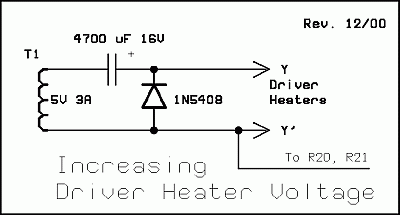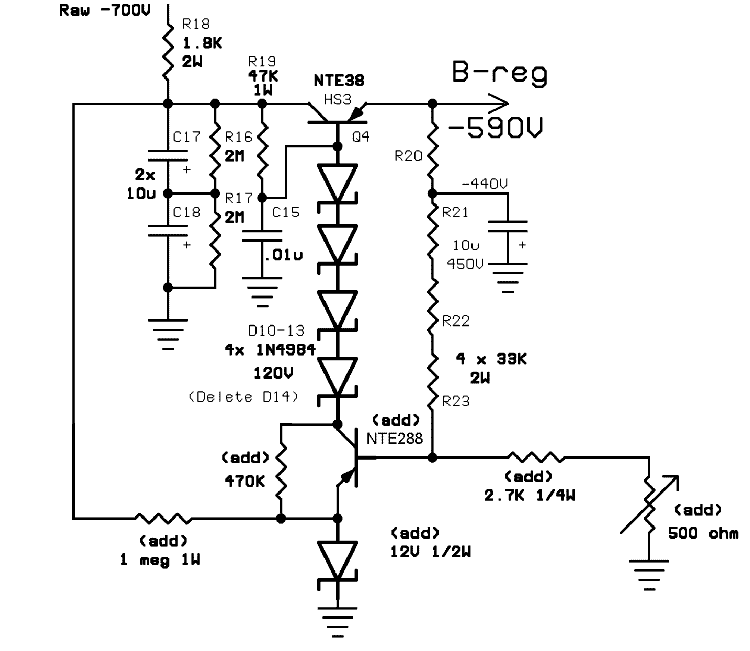A HI-FI VACUUM TUBE AMPLIFIER
by Fred Nachbaur, Dogstar Music ©1998, 2000
6: TWEAKS AND HACKS
A: Limiting Frequency Response
The "FX Loop" jacks can be used to insert a series capacitor to limit low-frequency response. A
value of 0.1 uF will typically be desirable to eliminate subsonics that could un-necessarily rob you
of available power.
Similarly, a capacitor can be placed in parallel (to ground) to limit high-frequency response,
should this be desirable. Experimentation is the best approach, you might find that a couple
hundred picofarads to ground will help eliminate the harshness of record pops on old vinyl or 78's.
B: Increasing Driver Filament Voltage
I admit it, this one is definitely in the "hacks" genre. It is a technique commonly used to squeeze
a bit more life out of oscilloscope CRT's by increasing the effective RMS filament voltage.
This can be used to advantage to boost the effective filament voltage to the driver tubes. While
they run just fine on 5VAC, the do warm up a bit slower than the rest of the tubes as a result.
This means that the output 6L6GC's can draw excessive current for a few seconds on power-up, if
the user forgets to flip off the Standby switch during warm-up. The result is often a blown fuse.
By speeding up the warm-up time of the driver tubes, the possibility of trouble is greatly
decreased. Allowing warm-up before applying B+ to the power amp is still recommended, but is
no longer as vital.
Interestingly, a side effect of this hack is that it slightly reduces the background noise (harmonics
of 60 Hz.) ... at least on the prototype.

Increasing Driver Filament Voltage
C: Stabilising the -590V Negative Regulator
The high-voltage zener diodes used to obtain the negative 590 volt reference tend to be rather
unstable with temperature. This can cause the regulated negative voltage (and therefore the
finals' grid bias) to drift considerably.
A substantial improvement is afforded by the modified circuit shown below. The transistor is a
general-purpose high-voltage (300 volts VBCE) small-signal unit. The 12 volt, 1/2 watt zener
diode is used as a reference instead. Note that the four 120V diodes are still used, except no
longer as a reference. Rather, they are kept as level-shifters to prevent excessive voltage across
the added regulator transistor.
A 500-ohm trim pot is also added to provide adjustability. Set it for an output voltage of -590
volts. Depending on individual component tolerances, etc. you might have to tweak the 2.7k
series resistor.

Improved -590V Regulation
D: Separate filament supply for Current-Source Pentodes
The filament arrangement for the driver circuit is technically in violation of maximum filament-to-
cathode voltage as regards the 6CB6A pentode. If this bothers you, you can use a separate low-
power transformer to supply filament power for these tubes. No need to rectify and filter to DC,
since there is no audio on these units. Reference the filament to the -590 V rail by tying one end
of the filament to the rail. The transformer used should be either 12.6VAC, 0.3A or better
(filaments in series) or 6.3VAC, 0.6A or better (filaments in parallel).
I tried it with a Hammond 191F24 (windings in parallel for 12.6VAC, 0.36A). There was no
measurable difference in performance, but it might set your mind at ease if you're concerned
about possible arc-over or filament emission.
If you implement this tweak, keep the supply to the 12AT7A filaments the same as before, but
reference it to the plate of the 6CB6A instead of to the tap on the resistive divider across the
negative supply.
E: Tube Substitutions
I don't recommend substituting any tubes in the preamp section, except that the 12AT7 can be
replaced with the European equivalent ECC81 or with 12AZ7A, and the 12AX7A's with ECC83.
In the driver section, several common pentodes will work in place of the 6CB6, including 6AU6 (a
good choice) and 6BA6 (a workable but slightly less stable alternative). You will have to
considerably increase R511/R611 in order to get the requisite bias adjustment range.
I haven't tried any output pentodes other than the 6L6GC, but quite a few devices (including
other 6L6GC variants as 6BG6GA or 807, 6CA7/EL34, and 6550/KT88 or KT90) should work just fine
here. An excellent tube, if you can find it at less than $200 a pair, would be the 8417.
END OF ARTICLE
Note: See also
LTP/CSS Driver Improvements (Sept. 2002)
(Use your
browser's "Back" button to return here)




